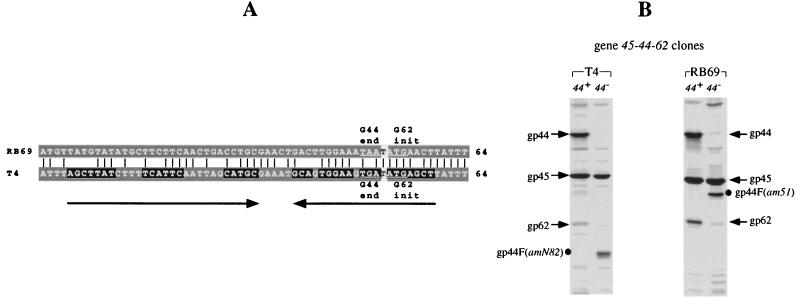FIG. 5.
Nucleotide sequences of the T4 and RB69 gene 44-62 junctures (A) and expression of cloned gene 62 from RB69 and T4 (B). (A) Open reading frames for genes 44 and 62, which are separated by one base pair at the g44-62 junctures of both T4 and RB69. The nucleotide sequence alignment shown is based on analysis of RB69 DNA clones derived from the λZAPII genomic library as well as PCR-amplified RB69 genomic fragments. The horizontal arrows underline the stem segment of a putative mRNA structure that has been suggested to play a role in translational coupling of gp62 to gp44 synthesis in T4 (29). No such structure can be predicted for RB69. (B) Results of plasmid-mediated expression of comparable genomic segments encompassing the gene 45-62 intervals from T4 mutant 44amN82 and RB69 mutant 44am51. The desired DNA segments were PCR amplified from the respective phage mutants as well as wild-type strains and cloned in λpLN vector, and their plasmid-mediated expression was subsequently analyzed in E. coli CAJ70 as described in Materials and Methods. The short arrows mark the positions of gp45, gp44, and gp62 bands on the SDS-PAGE autoradiogram (10% gel) from the experiment; dots mark the positions of gp44 amber fragments. Note that expression of gene 62 (from either T4 or RB69) is lower when DNA from gene 44 amber mutants is used than with DNA carrying the wild-type gene 44 alleles.

